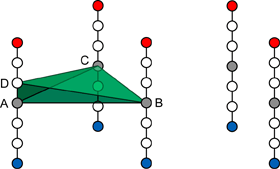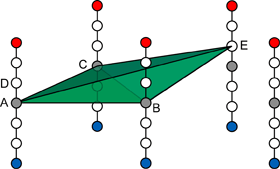When constructing a 3D mesh, the length of each tetrahedron's edge is compared to the average surface mesh length. If the ratio of an edge exceeds a defined value, the tetrahedron is said to have an internal long edge.
Tetrahedron (tetra) with internal long edges are detected with the Mesh Repair Wizard:  ().
().
Description
The mathematical analysis of a model has a basic assumption that the mesh is composed of uniform, equilateral tetra. This can never be the case and so it is important that a check is made for extremely distorted tetra which have the potential to affect the results. Internal long edges is a method used to measure the mesh quality. Other methods are Tetra With High Aspect Ratio and Tetra with Extreme Angles between Faces
When constructing a 3D mesh, intermediate nodes are inserted between surface nodes. Tetra are then formed between these nodes. Ideally, the most compact tetra will be formed (ABCD in the Figure 1 below). Other, less preferable tetras could also have been formed, (ABCE in Figure 2). Edge AE is obviously much longer than other edges and needs to be investigated.

Compact tetra

Internal long edge
Each edge throughout the model is expressed as a ratio of the local surface average edge length. If this ratio exceeds the user defined threshold value (default value is 2.5), an internal long edge is identified.
This tolerance helps ensure the size and shape of tetra around model features are appropriate. Elements with internal long edges are more likely to occur in regions where the surface mesh is not well matched.
Impact on the analysis
Tetra with internal long edges can cause distorted results. Temperature at a node, for example, takes into account the temperature of all nodes that it is attached to. Assume flow is from left to right in the Figure 2 above and the aim is to predicted the temperature at node E. Because of the larger distance between A and E, the contribution of the temperature at A to the predicted result for the temperature at E will be overstated in any calculations.
Recommended action
It is recommended that the number of internal long edges be minimized. It may not be necessary to eliminate all internal long edges if they occur in non critical parts of the mold. The Mesh Repair Wizard can help rectify this problem:  (). Alternatively:
(). Alternatively:  ().
().